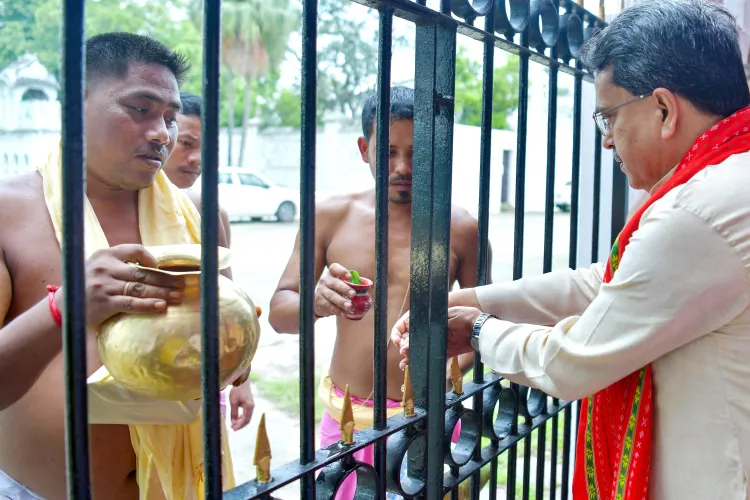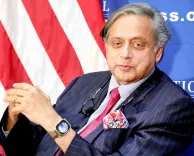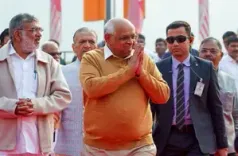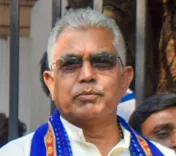Is the Centuries-old ‘Ker Puja’ a Symbol of Unity and Well-Being?

Synopsis
Key Takeaways
- ‘Ker Puja’ symbolizes faith, unity, and cultural heritage.
- It is celebrated two weeks after Kharchi Puja.
- Participation is primarily by indigenous tribal communities.
- Strict customs govern the puja to maintain its sanctity.
- The festival aims to enhance community spirit and ward off evil.
Agartala, July 19 (NationPress) The Chief Minister of Tripura, Manik Saha, remarked on Saturday that the age-old tradition of ‘Ker Puja’ stands as a testament to faith and unity, embodying the state's rich cultural legacy.
“During the Ker Puja festivities, I was privileged to seek blessings near the Ujjayanta Palace in Agartala,” the Chief Minister shared with the media after observing the century-old ritual from outside the designated puja area.
According to the customs of 'Ker Puja', entry into the designated areas is restricted to outsiders. This sacred event takes place in Agartala, various regions of Tripura, several other northeastern states, and the Chittagong Hill Tracts in Bangladesh.
The traditions surrounding Ker Puja dictate that activities related to death, birth, or even entertainment are strictly forbidden within the puja's designated areas. Organized by the indigenous tribal communities, this annual festival is characterized by intricate, time-honored rituals intended to promote the well-being of the populace and to dispel malevolent spirits.
The 'Ker Puja' occurs roughly two weeks following the Kharchi Puja, during which 14 Hindu deities are worshipped concurrently.
The seven-day Kharchi Puja took place at Puran Habeli, the historical capital of the former princely state, currently known as Khayerpur, located about 8 km north of Agartala.
The Chief Minister emphasized that a primary aim of this puja is to foster goodwill and uphold the spirit of brotherhood. Saha stated, “As we celebrate the traditional Ker Puja, I extend my heartfelt greetings and best wishes to the people of Tripura. It is well-known that this puja follows the Kharchi Puja held at the Chaturdash Devata Temple in Khayerpur. This longstanding tradition dates back to the reign of Maharaja Trilochan.”
He further explained that the puja continues to be performed in adherence to customs, and although it is now conducted in front of the royal palace, previously, the entire palace grounds were included within the Ker boundaries. “The Chantai (priests) who conduct the worship of the 14 deities at the Chaturdas Devta Temple have joined us here to carry out the rituals. We are grateful for their blessings,” Saha remarked, noting that a symbolic bamboo structure is venerated during this occasion.
The Chief Minister also noted that one of the objectives of Ker Puja is to encourage unity among the populace to combat diseases.
“This puja is performed for the development and overall prosperity of the state. It is carried out in accordance with tradition to ward off evil forces and prevent the spread of epidemics. The essence of Ker Puja is to cultivate a sense of brotherhood among us. Beyond being observed in front of the Ujjayanta Palace, many individuals from the Tripuri, Reang, and other tribal communities also observe this puja in their respective villages,” he added.
During the event, the Chief Minister also conveyed his best wishes to the residents of the state. He was accompanied by Finance Minister Pranajit Singha Roy, Rajya Sabha member Rajib Bhattacharjee, West Tripura District Magistrate Vishal Kumar, along with other officials and dignitaries.
On October 15, 1949, Tripura came under Indian governance following a merger agreement signed by Kanchan Prabha Devi, the then regent maharani, and the Indian Governor General. This agreement mandates the Tripura government to endorse 14 temples and puja, including Kharchi Puja, Ker Puja, and the Mata Tripura Sundari Temple (one of the 51 Shakti Peethas in the nation), which were previously managed by Hindu princely rulers.
Since the signing of this merger agreement, the Tripura government has been responsible for the festival's expenses for several decades.







